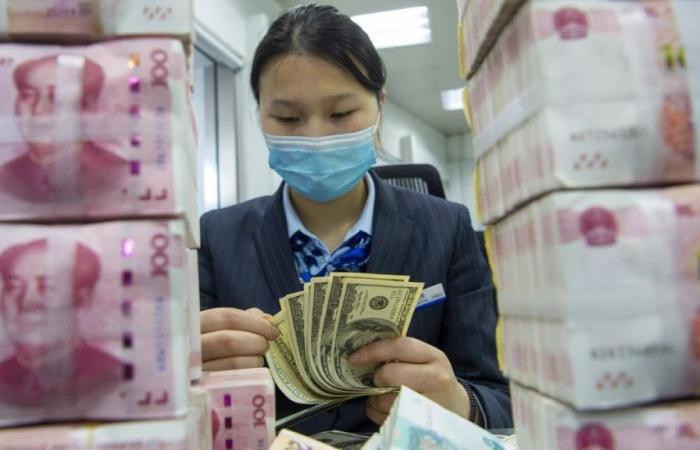Recent data from the IMF’s Monetary Composition of Official Foreign Exchange Reserves (COFER) point to an ongoing gradual decline in the dollar’s share of foreign exchange reserves allocated by central banks and governments.
Surprisingly, the reduced role of the US dollar over the last 2 decades has not been accompanied by increases in the share of the other ‘big 4’ currencies: the euro, the yen and the pound.
Rather, it has been accompanied by an increase in the proportion of what we have called ‘non-traditional reserve currencies’, including
- the Australian dollar,
- the canadian dollar,
- the chinese renminbi,
- the south korean won,
- the Singapore dollar and
- Nordic coins (crown of Sweden, Norway and Denmark).
won.jpg
Won, currency of South Korea.
Reorganizing
These non-traditional reserve currencies are attractive to reserve managers because they provide diversification and relatively attractive returns, and because they have become increasingly easier to buy, sell, and hold with the development of new digital financial technologies (such as automatic creation markets and automated liquidity management). These non-traditional reserve currencies are attractive to reserve managers because they provide diversification and relatively attractive returns, and because they have become increasingly easier to buy, sell, and hold with the development of new digital financial technologies (such as automatic creation markets and automated liquidity management).
This recent trend is even more surprising given the strength of the dollar, which indicates that private investors have shifted to dollar-denominated assets. Or so it would seem from the change in relative prices.
At the same time, this observation reminds us that exchange rate fluctuations can have an independent impact on the monetary composition of central banks’ reserve portfolios.
Changes in the relative values of different government securities, reflecting movements in interest rates, can have a similar impact, although this effect will tend to be smaller, to the extent that bond yields in major currencies generally vary. at the same time.
In any case, these valuation effects only reinforce the general trend. From a broader perspective, over the past 2 decades, the fact that the value of the US dollar has remained virtually unchanged, while the dollar’s share of global reserves has declined, indicates that central banks have effectively gone gradually moving away from the dollar.
At the same time, statistical evidence does not indicate an accelerated decline in the dollar’s reserve ratio, contrary to claims that US financial sanctions have accelerated the shift away from the dollar.
It is certainly possible, as some have argued, that the same countries seeking to stop holding dollars for geopolitical reasons do not report information on the composition of their reserve portfolios to the COFER.
Note, however, that the 149 reporting economies represent up to 93% of global foreign exchange reserves. In other words, non-reporters make up only a very small proportion of global reserves.
renminbis.jpg
Renminbi, China’s currency is advancing until 2022 but the trade war with the USA has hit it.
The renminbi
One non-traditional reserve currency that is gaining market share is the Chinese renminbi, whose gains equal a quarter of the decline in dollar share.
The Chinese government has been pushing policies on multiple fronts to promote the internationalization of the renminbi, including developing a cross-border payment system, extending swap lines and piloting a central bank digital currency.
Therefore, it is interesting to note that the internationalization of the renminbi, at least measured by the currency’s reserve ratio, shows signs of stagnation. The most recent data does not show a new increase in the renminbi’s monetary share: some observers may suspect that the depreciation of the renminbi exchange rate in recent quarters has masked increases in renminbi reserve holdings.
However, even adjusting for exchange rate variations confirms that the share of renminbi reserves has decreased since 2022. (N. de la R.: Within the framework of the global trade war with the USA, sanctions on its leading companies and also a geopolitical clash over Taiwan).
Some have suggested that what we have characterized as a continued decline in dollar holdings and an increase in the share of non-traditional currency reserves actually reflects the behavior of a handful of large reserve holders.
Russia has geopolitical reasons to be cautious about holding dollars, while Switzerland, which has built up reserves over the last decade, has reasons to hold a large fraction of its reserves in euros, with the eurozone being its geographic neighbor and partner. most important commercial. But when we exclude Russia and Switzerland from the COFER aggregate, using data published by their central banks from 2007 to 2021, we find little change in the overall trend.
In fact, this movement is quite broad. In our 2022 paper, we identified 46 “active diversifiers,” defined as countries with a share of foreign exchange reserves in non-traditional currencies of at least 5% at the end of 2020.
These include major advanced economies and emerging markets, including most countries. Economies of the Group of Twenty (G20). By 2023, at least 3 more countries (Israel, Netherlands, Seychelles) will have joined this list.
Dollar without hegemony
We also found that financial sanctions, when imposed in the past, induced central banks to modestly shift their reserve portfolios away from currencies, which risk being frozen and redistributed, in favor of gold, which can be stored in the country and is thus free from the risk of sanctions. That work also demonstrated that central bank demand for gold responded positively to global economic policy uncertainty and global geopolitical risk.
These factors may be behind further accumulation of gold by several emerging market central banks. However, before exaggerating this trend, it is important to remember that gold as a proportion of reserves remains historically low.
In short, the international monetary and reserve system continues to evolve. The patterns we highlighted above – a very gradual shift away from dollar dominance and an increasing role for non-traditional currencies of small, open, well-managed economies, enabled by new digital trading technologies – remain intact.
———————–
More content in Urgente24
Netflix will release an adaptation of a famous Agatha Christie novel
Steve Carell mocked the publicity failure of ‘The Rock’ Dwayne Johnson
Marvel fans celebrate that Taylor Swift will not be in Deadpool 3
Disney bets everything: Lilo and Stitch will return, but in the flesh






